Youtube's Evolved Something New. The official Tumblr of a new YouTube channel aiming to educate the public about paleontology.
Don't wanna be here? Send us removal request.
Photo

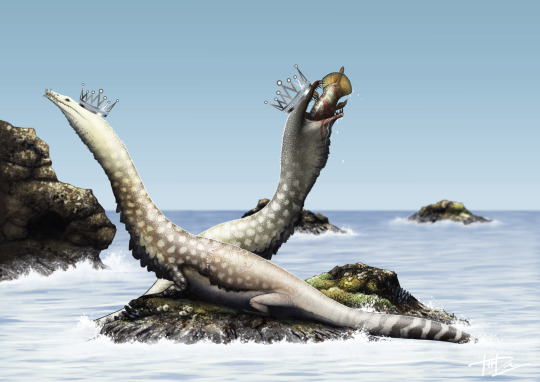
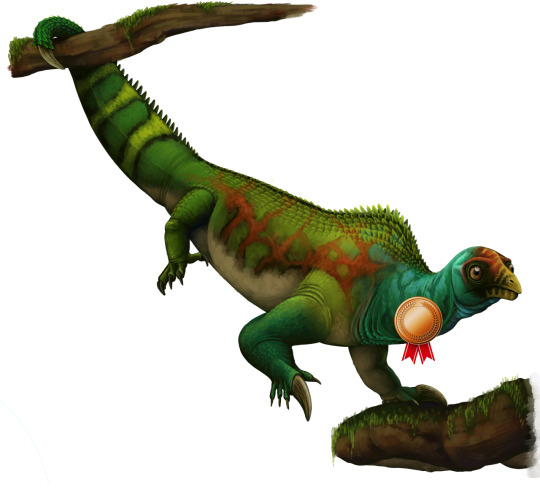
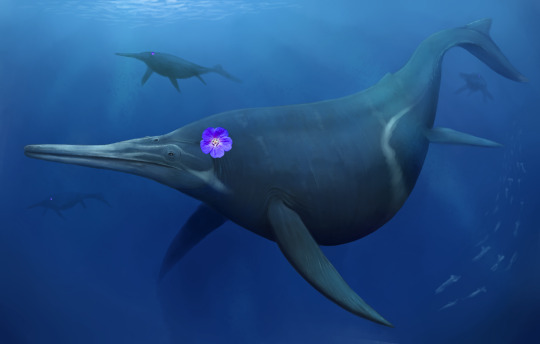

THE WINNER OF TRIASSIC MARCH MADNESS IS: POSTOSUCHUS!
In a result that surprises absolutely no one, Postosuchus is the winner of our final round in this year’s March Madness competition!
We had a record-breaking Five Hundred and Thirteen Votes, broken down as such below:

I assigned each first place vote a value of 4, each second place vote a value of 3, each third place vote a value of 2, and each fourth place vote a value of 1, and then added it up for each species as so:

Which lead to Postosuchus being in first place, followed closely by Nothosaurus, then a larger gap to Drepanosaurus, and with Shonisaurus in last place. What’s kind of hilarious is since around 150 votes or so, Nothosaurus has always been less than ten points behind Postosuchus - and it never managed to surpass it, not after five hundred votes! The appeal of the CrocoPup cannot be denied!
What a wonderful and harrowing competition this year everyone!!!!! Thank you all for playing - and I hope we all had fun learning about the weird and wacky animals of the Triassic Period!!!!!!!! Stay safe and Stay Healthy!
461 notes
·
View notes
Text
The Case For the Permian
So, by now everyone knows that in the Finale for Triassic March Madness there is a little question about which time Period we should do for next year’s March Madness
I am here to make a case for the Permian Period
Why do I want the Permian to be our pick for next year? The reasons are, ultimately, simple:
- The Permian, like the Triassic, is a time sandwiched between extinctions; namely, the collapse of the very wet Carboniferous world, and the end-Permian Mass Extinction. As such, it also has an extremely unique series of animals, especially on land
- This is also the first time that fully-terrestrial animals really could shine - the Amniotes got to take over the world. There are so many ODD Synapsids (almost mammals) and Sauropsids (almost reptiles) all over the place, and then they just… disappeared. Because of the end-Permian. There’s literally nothing like them!!!!!! What!!!!!!!!!!!!!!
- It was also a super COLD time on Earth, just coming out of the Karoo Ice Age, so life was turbulent. There were like, three minor extinctions IN the Permian as well as the two mass extinctions sandwiching it. Things just KEPT CHANGING and DIVErSIFYING and being WEIRD
- Since it was so recent, comparatively, to other things, we also actually know a lot about the things that lived in the Permian - unlike, say, some Cambrian weirdos, where all we can say is This is Weird ¯\_(ツ)_/¯
- There were large insects in the Permian too!!! There’s this weird idea that large insects are only Carboniferous-age and that’s… very wrong. There are also tons of interesting, more terrestrially adapted Temnospondyls
- Also like… the largest aquatic amphibian predator, Trematosaurus, which, what
- AND TONS OF FREAKY SHARKS LIKE HELICOPRION
- There will not be a Single Dinosaur
- I have a mighty need to show you guys the weirdness that is Parareptiles
- We get to talk about the decline of many Paleozoic-only groups, such as Trilobites and Eurypterids, while still talking about cool megafauna!!!
- Synapsid Fans deserve the Press
- I’m just going to present these images by @alphynix:
















Do the Right Thing Vote for the Permian for March Madness 2021
486 notes
·
View notes
Link
VOTING. FORM. ROUND. FOUR.
THE PENULTIMATE ROUND!
VOTE FOR YOUR FAVORITES THIS WEEK. ARGUE ABOUT THE MATCHES USING THE #TRIASSIC MARCH MADNESS TAG.
YOU CAN EDIT YOUR VOTE! IF YOU CHANGE YOUR MIND, BE SURE TO RECORD IT! YOU HAVE UNTIL 12:01 CENTRAL DAYLIGHT TIME ON MARCH TWENTY-EIGHTH TO COMPLETE YOUR FINAL VOTE!
MAKE SURE TO REBLOG THIS POST AND GET OUT THE VOTE!
CHECK THIS BLOG FOR INFO ON ALL CONTESTANTS!
172 notes
·
View notes
Link
VOTING FORM FOR ROOOOOUNNNDDDD TWOOOOOO!
VOTE FOR YOUR FAVORITES THIS WEEK. ARGUE ABOUT THE MATCHES USING THE “#TRIASSIC MARCH MADNESS” TAG.
YOU HAVE UNTIL 12:01 AM CENTRAL DAYLIGHT TIME ON MARCH FOURTEENTH TO COMPLETE YOUR VOTE!
MAKE SURE TO REBLOG THIS POST AND GET OUT THE VOTE!
CHECK THIS BLOG FOR INFO ON ALL CONTESTANTS!
202 notes
·
View notes
Link
HERE WE GO: THE VOTING FORM!
VOTE FOR YOUR FAVORITES THIS WEEK. ARGUE ABOUT THE MATCHES USING THE “#TRIASSIC MARCH MADNESS” TAG.
YOU HAVE UNTIL 12:01 AM CENTRAL STANDARD TIME ON MARCH SEVENTH TO COMPLETE YOUR VOTE!
MAKE SURE TO REBLOG THIS POST AND GET OUT THE VOTE!
CHECK THIS BLOG FOR INFO ON ALL CONTESTANTS!
381 notes
·
View notes
Link
HERE WE GO: THE VOTING FORM!
VOTE FOR YOUR FAVORITES THIS WEEK. ARGUE ABOUT THE MATCHES USING THE “#TRIASSIC MARCH MADNESS” TAG.
YOU HAVE UNTIL 12:01 AM CENTRAL STANDARD TIME ON MARCH SEVENTH TO COMPLETE YOUR VOTE!
MAKE SURE TO REBLOG THIS POST AND GET OUT THE VOTE!
CHECK THIS BLOG FOR INFO ON ALL CONTESTANTS!
381 notes
·
View notes
Photo

Y O U R T R I A S S I C M A D N E S S B R A C K E T
117 notes
·
View notes
Text
Megachirella
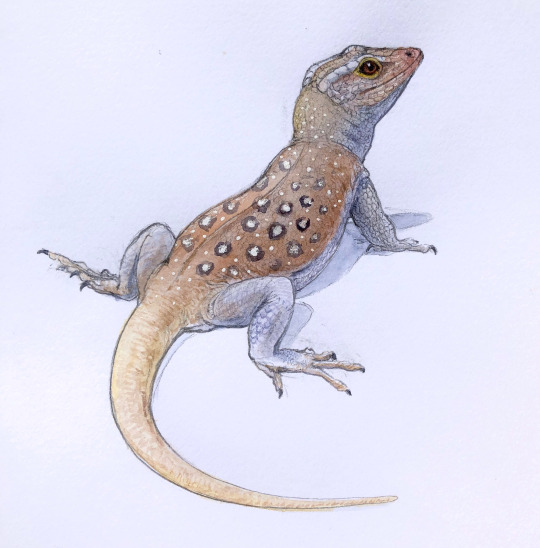
By Ripley Cook
Etymology: Small thing with big hands
First Described By: Renesto and Posenato, 2003
Classification: Biota, Archaea, Proteoarchaeota, Asgardarchaeota, Eukaryota, Neokaryota, Scotokaryota, Opimoda, Podiata, Amorphea, Obazoa, Opisthokonta, Holozoa, Filozoa, Choanozoa, Animalia, Eumetazoa, Parahoxozoa, Bilateria, Nephrozoa, Deuterostomia, Chordata, Olfactores, Vertebrata, Craniata, Gnathostomata, Eugnathostomata, Osteichthyes, Sarcopterygii, Rhipidistia, Tetrapodomorpha, Eotetrapodiformes, Elpistostegalia, Stegocephalia, Tetrapoda, Reptiliomorpha, Amniota, Sauropsida, Eureptilia, Romeriida, Disapsida, Neodiapsida, Sauria, Lepidosauromorpha, Lepidosauriformes, Lepidosauria, Squamata
Status: Extinct
Time and Place: 242 million years ago, in the Anisian of the Middle Triassic.
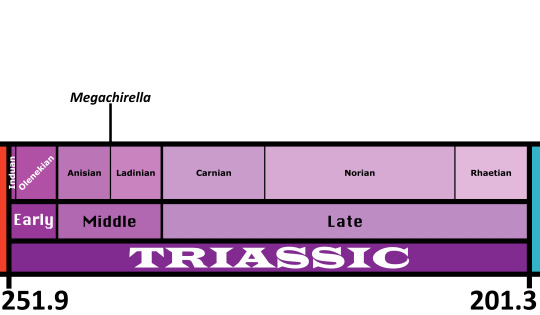
Megachirella is known from the Italian Alps.

Physical Description: Megachirella would have looked very… lizardy. Which makes sense, seeing as it is the earliest known lizard. It had a relatively large skull with large eyes and tiny pointy teeth (which would have been barely noticeable, like the teeth of geckos). Its body was long and had short, sprawling limbs. The front limbs had large hands (which give it its name). Each finger was short and bore decently-sized claws. It probably also had a long tail, but we don’t know for sure because only the front half of the holotype specimen was recovered. It’s estimated at being no greater than 20 cm long.
Diet: Megachirella was probably insectivorous, going off of its small, numerous teeth.
Behavior: Megachirella may have spent some of its time in trees, based on the large hands and stout fingers that would have given it a powerful grip. However it doesn’t show the mass of adaptations for living in trees that some lizards like chameleons do; in this regard, it was probably more comparable to anolid lizards.
Ecosystem: Megachirella was found in a unit of rock in the Dolomites in Italy. This deposit has yielded 17 kinds of fossil plants, as well as more sparse remains of bivalves, gastropods, ammonites, and fish, Based on this, and the fact that the rock formation has alternating units of terrestrial and marine fauna, Megachirella seems to have lived along a well-forested coastline. This area was likely hit regularly by storms that would have caused rapid burial.
Other: Megachirella has been surprisingly well-studied. The fossil is only about half of the animal, but the fossil block has been described three times, one of which involved micro-CT scanning. It was originally described as being outside the tuatara-squamate clade, but the micro-CT scanning revealed many anatomical details that it has in common with squamates. Thus, it’s the oldest known lizard!
~ By Henry Thomas
Sources under the cut
Keep reading
159 notes
·
View notes
Text
Placodus
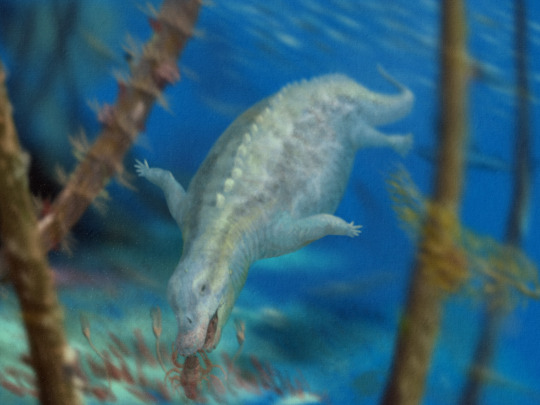
By @stolpergeist
Etymology: Flat Tooth
First Described By: Agassiz, 1833
Classification: Biota, Archaea, Proteoarchaeota, Asgardarchaeota, Eukaryota, Neokaryota, Scotokaryota, Opimoda, Podiata, Amorphea, Obazoa, Opisthokonta, Holozoa, Filozoa, Choanozoa, Animalia, Eumetazoa, Parahoxozoa, Bilateria, Nephrozoa, Deuterostomia, Chordata, Olfactores, Vertebrata, Craniata, Gnathostomata, Eugnathostomata, Osteichthyes, Sarcopterygii, Rhipidistia, Tetrapodomorpha, Eotetrapodiformes, Elpistostegalia, Stegocephalia, Tetrapoda, Reptiliomorpha, Amniota, Sauropsida, Eureptilia, Romeriida, Diapsida, Neodiapsida, Sauria, Archosauromorpha?, Archelosauria, Pantestudines, Sauropterygia, Placodontiformes, Placodontia, Placodontoidea, Placodontidae
Referred Species: P. gigas, P. inexpectatus
Time and Place: Between 245 and 237 million years ago, from the Anisian to the Landinian of the Middle Triassic

Placodus is known across the Tethys Sea

Physical Description: Placodus is an aquatic reptile with a certain amount of flair, to a truly excessive and ridiculous degree. With a lorge body, small limbs with webbed feet, and long flattened undulating paddle tail, it would be weird enough just from its skeleton. But it’s skull is bizarre on top of that! The skull is fairly short and small, with teeth forming a sort of hodgepodge beak sticking out of the mouth and extremely large eyes. The weirdest feature of all, however, were the large flat teeth on the inside of Placodus’s jaw, literally sitting on the bottom of its mouth along with other flat teeth along the sides of the jaw. A similar pattern was repeated on the lower jaw. This is not only wild, it gave Placodus unique adaptations for feeding in the overcrowded waters of the Middle Triassic Tethys Sea. It had a very rigid body, so it wasn’t able to move around very rapidly; in addition to this, it had very dense bones in general, especially with respect to its ribs. Placodus had a row of knobs on its backbone and, in general, was very heavily armored. All in all, an absolutely ridiculous appearing creature.
Diet: The flat teeth of Placodus would have been invaluable in crushing hard-shelled invertebrates such as molluscs, brachiopods, and crustaceans.
Behavior: Placodus was so heavy to the point of me, personally, questioning how it was able to rise to the surface at all. As such, it would have utilized its own density to lower itself to the sea floor, combing the bottom of the continental shelf and looking for food. Using the shovel-like teeth, it could pull up animals from the dirt and sand, and draw them into its mouth. Then, Placodus would crush them with the flat teeth, utterly obliterating them in the process. It utilized the parietal eye to help with orientation in the water, which it would need as it moved up and down in the ocean. The tail would have been its main method of locomotion; its limbs, while webbed, would have been only useful in light steering. On land, Placodus would have been utterly useless - very clumsy and slow moving, and always keeping close to the sea. That said, it doesn’t seem to be so heavily adapted for the ocean that it would have given birth to live young. It wouldn’t have had to worry much about predators, as it was so bulky and well-armed that anything biting it would have lost a tooth or two!
Ecosystem: Placodus, much like Nothosaurus, was a common feature in the Tethys Sea. It mainly stuck near the shores, seeing as it wasn’t very well adapted for walking; it would then be able to dive quickly for water and stick to the bottom of the sea for its food. As such, most inhabitants of the Middle Triassic Tethys would probably have encountered Placodus, or something very like it, at one time or another. These would have included a variety of Ichthyosaurs like Cymbospondylus and Tholodus, Nothosaurus, early Plesiosaur relatives like Wumengosaurus and Pistosaurus, other Placodonts such as Cyamodus, sharks like Hybodus, and of course a variety of invertebrates and other fish.
Other: Placodonts like Placodus were extremely common in the Triassic. Interestingly enough, as weird as Placodus was, it was one of the earlier ones in the Placodont family tree - and lacked many of the later adaptations seen in the group. Many later Placodonts would evolve shells like living turtles, in order to help protect them from predators even further - some even shortening their tails and clearly becoming better adapted for marine life than their older cousin Placodus. Fascinatingly, however, they evolved these turtle-like proportions and features independently of turtles - while it seems that turtles are actually closely related to them (and that Placodonts fall in the “stem-turtle” group, i.e. all animals more closely related to turtles than to other groups of living reptiles), the shells of the different groups came about very differently, and in fact Placodus does not even remotely resemble similarly-niched animals like Odontochelys. Just goes to show that the Turtle™ method of Self Protection was a popular choice!
Species Differences: The main differences between the two species is that P. gigas is found on the Western Coast of the Tethys Sea, while P. inexpectatus is mainly known from the Eastern Coast.
~ By Meig Dickson
Sources Under the Cut
Keep reading
149 notes
·
View notes
Text
Nothosaurus
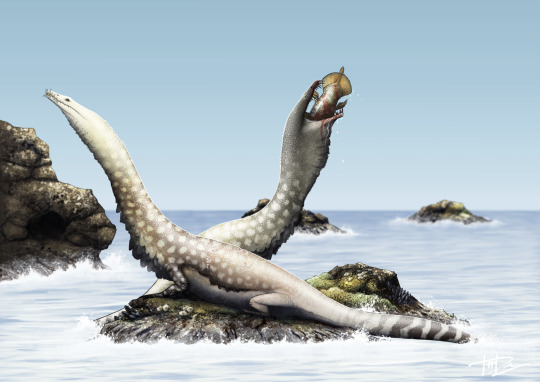
By Tas Dixon
Etymology: False Reptile
First Described By: Münster, 1834
Classification: Biota, Archaea, Proteoarchaeota, Asgardarchaeota, Eukaryota, Neokaryota, Scotokaryota, Opimoda, Podiata, Amorphea, Obazoa, Opisthokonta, Holozoa, Filozoa, Choanozoa, Animalia, Eumetazoa, Parahoxozoa, Bilateria, Nephrozoa, Deuterostomia, Chordata, Olfactores, Vertebrata, Craniata, Gnathostomata, Eugnathostomata, Osteichthyes, Sarcopterygii, Rhipidistia, Tetrapodomorpha, Eotetrapodiformes, Elpistostegalia, Stegocephalia, Tetrapoda, Reptiliomorpha, Amniota, Sauropsida, Eureptilia, Romeriida, Diapsida, Neodiapsida, Sauria, Archosauromorpha?, Archelosauria, Pantestudines, Sauropterygia, Eosauropterygia, Nothosauria, Nothosauridae, Nothosaurinae
Referred Species: N. mirabilis, N. cristatus, N. cymatosauroides, N. edingerae, N. giganteus, N. haasi, N. jagisteus, N. marchicus, N. mirabilis, N. tchernovi, N. yangjuanensis, N. zhangi
Time and Place: From 242 million years ago until 208 million years ago, from the Ladinian of the Middle Triassic through the earliest Rhaetian of the Late Triassic
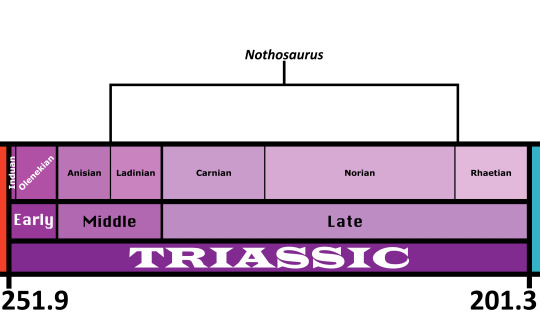
Nothosaurus is known from all over Eurasia and North Africa, to the point that it’s pointless to list all the locations. Just assume that if it’s the Mid or Late Cretaceous of the Tethys Sea, Nothosaurus is there.
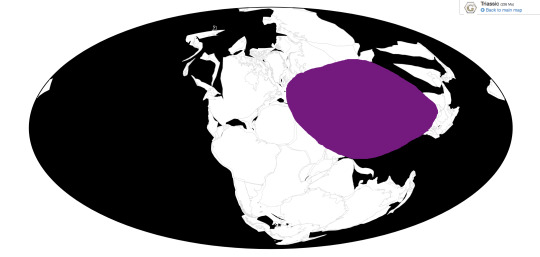
Physical Description: Nothosaurus is an iconic Triassic marine reptile - to the point that we had to include it, or else we would have violated some sort of rule of paleontology. Nothosaurus was about 4 meters long on average, but could reach up to 7 meters in length. It had a long, streamlined body, with a long neck and a long tail. Its head was narrow and filled with long and pointed teeth which interlocked together when the mouth closed, forming a tight trap. Its forelimbs were longer than its hind limbs, and all of its hands and feet had webbing between the long toes. In a lot of ways, it looked extremely similar to later marine reptiles to which it was closely related, like the Plesiosaurs and Pliosaurs, just with hands instead of proper flippers - however, current evidence indicates that the Plesiosaurs and Pliosaurs evolved from an ancestor of both groups, and Nothosaurus is just a Triassic offshoot. It had capabilities for diving in the water, though it also was still adapted for life on the shore.
Diet: Nothosaurus primarily ate fish and other marine animals, including other marine reptiles.
Behavior: Nothosaurus was semi-aquatic, spending a lot of its time both in the ocean and on land. On the beaches and shores it would rest and sleep, and then turn to the ocean for most of its everyday life. Diving for food would have been most of its daily activities, going after juvenile reptiles and large fish in the water and diving in order to reach it. It probably would have paddled with its webbed feet, and undulated its body to some extent to help propel forward. It may have been at least somewhat social, living in groups and colonizing the shores together before going for group dives for food. Interestingly enough, Nothosaurus was basically like a reptilian seal, coming up to shore to rest and sit with its relatives. Whether or not they would have given birth to live young is uncertain; while their close relatives, the Plesiosaurs, did; they retained enough land adaptations to allow them to lay eggs on the shore. More research as to their physiology is needed in order to determine that aspect of their life history. Trackways have been attributed to Nothosaurus, which may show that they rowed their paddles on the sea bed to shake up small animals trapped underneath; this would have allowed Nothosaurus to capture the invertebrates between its long teeth and hold onto them so they could not escape.
Ecosystem: Nothosaurus lived throughout the early Tethys sea, and was a common feature in many communities throughout this growing body of water during the Middle and Late Triassic. It would have stuck to the coasts for the most part, but still ventured out into deep and open water. As such, it’s rather difficult to list all the different animals it lived alongside - it’s found in Bulgaria, China, France, Germany, Hungary, Israel, Italy, Jordan, the Netherlands, Poland, Saudi Arabia, Spain, and Switzerland. So just, assume that a marine creature from the Tethys during this time lived with Nothosaurus rather than not.
Other: Nothosaurus has been treated as, unfortunately, a wastebasket taxon - it was discovered early enough in the history of paleontology as a science that many similar animals were just dumped into this name without any specific studies done. So, determining the factual relationships from this mess is still being worked out; in fact, it seems that this genus is paraphyletic, with many close relatives of Nothosaurus being more closely related to some species than to others. So that’s fun!
Species Differences: The varying species of Nothosaurus tend to differ based on where and when they lived, rather than any particularly notable differences. There are some differences in size and limb proportions as well, but in general the differing species of Nothosaurus would have had very similar ecological roles.
~ By Meig Dickson
Sources Under the Cut
Keep reading
308 notes
·
View notes
Text
Thalattosaurus

By @stolpergeist
Etymology: Ocean reptile
First Described By: Merriam, 1904
Classification: Biota, Archaea, Proteoarchaeota, Asgardarchaeota, Eukaryota, Neokaryota, Scotokaryota, Opimoda, Podiata, Amorphea, Obazoa, Opisthokonta, Holozoa, Filozoa, Choanozoa, Animalia, Eumetazoa, Parahoxozoa, Bilateria, Nephrozoa, Deuterostomia, Chordata, Olfactores, Vertebrata, Craniata, Gnathostomata, Eugnathostomata, Osteichthyes, Sarcopterygii, Rhipidistia, Tetrapodomorpha, Eotetrapodiformes, Elpistostegalia, Stegocephalia, Tetrapoda, Reptiliomorpha, Amniota, Sauropsida, Romeriida Diapsida, Neodiapsida, Thalattosauria, Thalattosauroidea, Thalattosauridae
Referred Species: T. alexandrae, T. borealis, T.? shastaensis
Status: Extinct
Time and Place: 237 to 221 million years ago, from the Carnian to the Norian of the Late Triassic

Thalattosaurus is known from California and British Columbia.
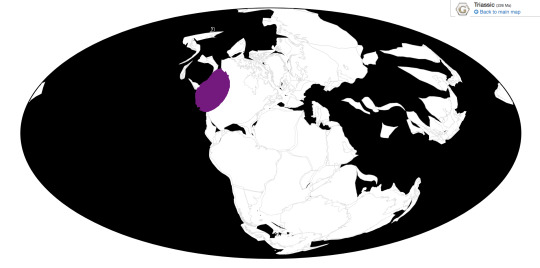
Physical Description: Thalattosaurus was a member of the thalattosaurs, a clade of marine reptiles endemic to the Triassic. It had a long and slender body, about 2 meters (7 feet) long with a powerful, paddle-like tail. Like Askeptosaurus, which we have talked about before, Thalattosaurus’s limbs were likely webbed, but not heavily modified into paddles - they still had distinct fingers and claws.
Thalattosaurus’s skull is where things get weird. The front of the upper snout is distinctly downturned and narrower than the corresponding part of the lower jaw. The premaxilla lacked teeth, but had blunt “pseudodont” projections that resembled teeth. Actual teeth were present on the lower jaw and in the back of the jaws, which were robust. The lower jaw had pointy teeth anteriorly and both jaws had broad, bumpy teeth posteriorly. The eye sockets were large and the nares were directed somewhat dorsally.
Diet: The broad, chunky teeth in the back of the jaws suggest Thalattosaurus ate shellfish of various sorts, although I doubt it was particularly picky and wouldn’t turn down a fish or two.
Behavior: Although Thalattosaurus was a good swimmer, it likely spent a good amount of its time on the shore resting and sunning, going out to sea to feed. Its claws would have been useful for clinging onto rocks in heavy surf. It may have caught cephalopods such as ammonites in the open water, using the anterior teeth and pseudodonts to pry out the fleshy bits from the shell (or, failing that, just crush the shell with the back teeth). If I may speculate, it may have also rooted through the sandy seafloor for buried shellfish.
Ecosystem: Thalattosaurus alexandrae and T.? shastaensis are known from the Hosselkus Limestone of California. This was a coastal marine environment, and was also home to the thalattosaur Nectosaurus, the giant ichthyosaur Shastasaurus, and the sharks Hybodus and Acrodus. T. borealis is known from the slightly earlier Sulphur Mountain Formation of British Columbia, which was also home to conodonts, the thalattosaur Paralonectes, and the relatively small ichthyosaur Pharalodon.
Other: The T. alexandrae fossils were collected in the early 1900’s by a team from the University of California. The expedition was very fruitful, recovering many marine reptile remains representing at least three genera, although the area was filled with mountain lions. The recovered material is probably stored in the same building where I wrote this post (although I know at least some of the UCMP’s marine reptile material is stored in a clock tower on campus).
~ By Henry Thomas
Sources under the cut
Keep reading
140 notes
·
View notes
Text
Tanystropheus

By @stolpergeist
Etymology: Long hinge
First Described By: Meyer, 1852
Classification: Biota, Archaea, Proteoarchaeota, Asgardarchaeota, Eukaryota, Neokaryota, Scotokaryota, Opimoda, Podiata, Amorphea, Obazoa, Opisthokonta, Holozoa, Filozoa, Choanozoa, Animalia, Eumetazoa, Parahoxozoa, Bilateria, Nephrozoa, Deuterostomia, Chordata, Olfactores, Vertebrata, Craniata, Gnathostomata, Eugnathostomata, Osteichthyes, Sarcopterygii, Rhipidistia, Tetrapodomorpha, Eotetrapodiformes, Elpistostegalia, Stegocephalia, Tetrapoda, Reptiliomorpha, Amniota, Sauropsida, Eureptilia, Romeriida, Disapsida, Neodiapsida, Sauria, Archosauromorpha, Tanystropheidae
Referred Species: T. longobardicus, T. meridensis
Status: Extinct, sadly
Time and Place: Tanystropheus lived in the middle Triassic, about 245 to 237 million years ago.

Fossils of Tanystropheus have been found in Europe, Israel, and southern China.

Physical Description: Tanystropheus is rare among Triassic weirdos in being reasonably well-known among non-specialists, though rarely by name. The reason it’s so well-known? That truly, ridiculously, insanely long neck. Its neck was so long, in fact, that it made up over half of its body length—and this is not a short animal we’re talking about, with adults reaching up to six metres in length. The neck is made up of 13 elongated vertebrae, and these vertebrae were hollow.

(Image: A skeletal reconstruction of Tanystropheus, showing its extremely long neck and small head. Image by Mark Witton [Source])
You might notice a few other interesting things from this skeletal. Firstly, the body is surprisingly skinny, not enormously round as in many other long-necked animals (see: sauropod dinosaurs). The neck vertebrae have elongated cervical ribs that would have probably hindered motion as well as helped support the neck.

(Image: Diagram of the skull of juvenile Tanystropheus. It is a roughly triangular skull with a large eye and conical, interlocking teeth at the front and triple-cusped teeth in the back. Image from Nosotti, 2007)
Tanystropheus had interlocking, conical teeth in the front of its mouth. Interestingly, juveniles seem to have had triple-cusped teeth in the “cheek” region (though they lacked cheeks), while adults had more needle-like teeth.
Diet: If its conical, interlocking teeth weren’t enough evidence of diet, the fossils of fish scales and squid suckers inside its stomach are. Tanystropheus was piscivorous.
Behavior: The behaviour of Tanystropheus has been a source of some contention. Aside from the brief time it was thought to be a flying animal (crazy, right? The long vertebrae were mistaken for pterosaur wing bones), it’s been assumed to be an aquatic or semi-aquatic animal. However, debate has remained over whether it was a swimming marine predator or the Triassic equivalent of a heron.
Frankly, I think the evidence is pretty one-sided. With a stiffened, poorly-muscled neck, a tail that isn’t flattened from side-to-side, and air-filled vertebrae, Tanystropheus bears little resemblance to marine predators, and likely lived a more heron-like lifestyle.
Ecosystem: Tanystropheus fossils are found in marine or freshwater deposits, and it seems likely that it made its home alongside watercourses or shorelines. As evidenced by stomach contents it clearly lived alongside squid and fish; these rocks also contain ichthyosaurs, bivalve molluscs, and protomammals.
~ by Hayley Orlowski
Sources Under the Cut
Keep reading
423 notes
·
View notes
Text
Desmatosuchus

By @apsaravis
Etymology: Linked crocodile
First Described By: Case, 1920
Classification: Biota, Archaea, Proteoarchaeota, Asgardarchaeota, Eukaryota, Neokaryota, Scotokaryota, Opimoda, Podiata, Amorphea, Obazoa, Opisthokonta, Holozoa, Filozoa, Choanozoa, Animalia, Eumetazoa, Parahoxozoa, Bilateria, Nephrozoa, Deuterostomia, Chordata, Olfactores, Vertebrata, Craniata, Gnathostomata, Eugnathostomata, Osteichthyes, Sarcopterygii, Rhipidistia, Tetrapodomorpha, Eotetrapodiformes, Elpistostegalia, Stegocephalia, Tetrapoda, Reptiliomorpha, Amniota, Sauropsida, Eureptilia, Romeriida, Disapsida, Neodiapsida, Sauria, Archosauromorpha, Crocopoda, Archosauriformes, Eucrocopoda, Archosauria, Pseudosuchia, Aetosauria, Stagonolepididae, Desmatosuchinae
Referred Species: D. spurensis, D. smalli
Status: Extinct
Time and Place: 237 to 208 million years ago, from the Carnian to the Norian of the Late Triassic

Desmatosuchus is known from Arizona, New Mexico, Texas, and Wyoming.

Physical Description: Desmatosuchus was yet another weird crocodile relative. It grew up to around 4.5 meters (15 feet) in length. Its head was small relative to its body size, and had a narrow, slightly upturned snout. The front of the upper snout was slightly expanded, forming a shovel-like structure. The teeth, which were only present in the backs of the jaws, were peg-shaped. It would have stood pretty much upright off the ground, although the limbs were not very flexible. The body was heavily armored, with the back being covered with a row of blocky osteoderms and bordered by a row of triangular osteoderms on each side. On the neck and over the shoulders, these had grown into large, backward-curved spikes.
Diet: Desmatosuchus was likely primarily herbivorous, although a degree of omnivory (for example, also eating insects) is not off the table, based on a few anatomial similarities to armadillos.
Behavior: Desmatosuchus like used its shovellike snout to uproot soft plants from the ground. This is slightly similar to modern pigs, but with less rooting around because Desmatosuchus probably didn’t have any movable fleshy bits to its snout. When chewing, the lower jaw would have fit almost perfectly into the upper jaw, to help shear soft plant material. Desmatosuchus lived in herds, possibly of related individuals - there are instances of Desmatosuchus fossils being found together in quarries, with up to 14 individuals found associated in the Placerias Quarry of Arizona. The spikes on its neck and shoulders were likely used for defense against predators such as Postosuchus, but given the size of them can vary dramatically, they may have also been used for visual display.
Ecosystem: Desmatosuchus is - yet again - from late Triassic North America! We’ve been over what lived in this area many times before. In one instance, Desmatosuchus was found in association with, among other things, temnospondyls, poposaurids, a pterosaur, and what was either an early ornithischian or Revueltosaurus. This assemblage only spans one meter of Dockum Group rock, suggesting that it was deposited there by a flash flood. Desmatosuchus probably hung around waterways, as it’s often found alongside phytosaurs and temnospondyls.
Other: There are two species of Desmatosuchus: D. spurensis and D. smalli. D. smalli lived later than D. spurensis and, among other minor differences, had fewer teeth and larger spikes.
~ By Henry Thomas
Sources under the cut
Keep reading
180 notes
·
View notes
Text
Askeptosaurus italicus

By Ripley Cook
Etymology: Unconsidered Reptile
First Described By: Nopcsa, 1925
Classification: Biota, Archaea, Proteoarchaeota, Asgardarchaeota, Eukaryota, Neokaryota, Scotokaryota, Opimoda, Podiata, Amorphea, Obazoa, Opisthokonta, Holozoa, Filozoa, Choanozoa, Animalia, Eumetazoa, Parahoxozoa, Bilateria, Nephrozoa, Deuterostomia, Chordata, Olfactores, Vertebrata, Craniata, Gnathostomata, Eugnathostomata, Osteichthyes, Sarcopterygii, Rhipidistia, Tetrapodomorpha, Eotetrapodiformes, Elpistostegalia, Stegocephalia, Tetrapoda, Reptiliomorpha, Amniota, Sauropsida, Eureptilia, Romeriida, Disapsida, Neodiapsida, Thalattosauria, Askeptosauroidea, Askeptosauridae
Time and Place: Between 247 and 235 million years ago, from the Anisian to the Ladinian of the Middle Triassic

Askeptosaurus is known from the Besano Formation of Switzerland, as well as the Gejiu Formation of China

Physical Description: Askeptosaurus was a Thalattosaur, a group of strange ancient offshoots, not even proper reptiles - stem-reptiles, not more closely related to any living reptile group than any other - and a fascinating experiment in marine life for land vertebrates completely unique to the Triassic. Like other Thalattosaurs, Askeptosaurus had a long and slender body for streamlined movement through the water. Its tail was built into a paddle, to help with propulsion forward. While their feet were shaped into decent sized paddles, they weren’t adapted into flippers like more thoroughly marine species of reptile. Askeptosaurus also had a long tail and long neck, and an extremely long snout. In fact, this long snout is characteristic of the group of Thalattosaurs Askeptosaurus was a part of. This long, narrow, and pointed skull pushed the nostrils back so they were actually close to the eyes, which themselves were extremely large with a large bony ring around the eye socket. It had very small teeth, though of note - one of its close relatives was toothless, and other Thalattosaurs had distinctively downturned snouts instead. Askeptosaurus had dozens and dozens of teeth all across its mouth, and it also had a lowly-spined back, different from its relatives. It had very slender limbs as well, compared to its relatives. It was probably somewhere between two and three meters long from tail to snout, though that is an extremely rough estimate on my end and no official measurement of its body length has been made.
Diet: Given its many pointed teeth, Askeptosaurus was decidedly a fish eater.
Behavior: Askeptosaurus would have used its paddle-esque feet and hands to steer itself through the water, using the angle and extension of its limbs to turn this way and that. The undulating, long body would have swimped from side to side in order to propel it forward and increase or decrease speed. That extremely long snout was extremely useful for reaching out and grabbing food hiding in rock crevices and other hiding places, as well as for grabbing wriggly and slippery fish and preventing their escape. Askeptosaurus also shows extensive adaptations for deep diving - large eyes suited for low light conditions, as well as a protective ring and strong bones to help in preventing bodily collapse at deep depths. That said, it is at least somewhat a mystery still - did it give birth to live young? Did it live in groups? Given its fairly pad-like limbs, did it spend any time on land? More research on this beautiful group of Triassic creatures is needed to understand their place in the ocean ecosystems.
Ecosystem: Askeptosaurus tended to live near the coasts, still in deep and marine and open habitats but close enough that if it did crawl onto the shore, it would have been able to without going too far out of its way. It seems, based on its distribution, that Askeptosaurus lived throughout the burgeoning Tethys sea, though of course more fossils of this animal in other locations would be helpful to confirm that. It didn’t live near reefs, and preferred open ocean habitats. There was a wide variety of ammonites, brachiopods, snails, and fish - the last of which were, of course, the main prey of Askeptosaurus. As far as reptilian neighbors, there were other Thalattosaurs like Hescheleria and Clarazia; Tanystropheids like Tribelesodon, Tanystropheus, and Macrocnemus; Helveticosaurids like Helveticosaurus and Eusaurosphargis; Placodonts like Paraplacodus and Cyamodus; Ichthyosaurs such as Cymbospondylus and Mixosaurus; Pachypleurosaurus like Keichosaurus, Serpianosaurus and Pachypleurosaurus; Suchians such as Ticinosuchus; and Nothosaurs like Nothosaurus and Lariosaurus. So, an extremely diverse ecosystem - where different marine reptiles had to carve out their own roles for survival - was the cacophony that Askeptosaurus called home.
Other: Thalattosaurs seem to be completely separate from all other reptiles, not even in the crown group - in the Neodiapsids, a group that diverged in the Permian and eventually lead to proper reptiles and their relatives, but Askeptosaurus and other Thalattosaurs broke off from in that time. That means that there should be fossil Thalattosaurs in the Permian, or at least their precursors. Sadly, we do not have them. More research is needed to understand their origins, though their diversity and evolution in the Triassic is fairly clear. Sadly, the end-Triassic extinction killed this beautiful group, and their role in the ecosystem would be replaced by other ,more familiar marine reptiles.
~ By Meig Dickson
Sources Under the Cut
Keep reading
143 notes
·
View notes
Text
Odontochelys semitestacea
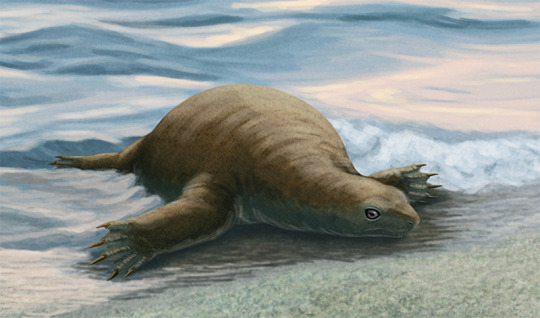
By @alphynix
Etymology: Toothed Turtle
First Described By: Lie et al., 2008
Classification: Biota, Archaea, Proteoarchaeota, Asgardarchaeota, Eukaryota, Neokaryota, Scotokaryota, Opimoda, Podiata, Amorphea, Obazoa, Opisthokonta, Holozoa, Filozoa, Choanozoa, Animalia, Eumetazoa, Parahoxozoa, Bilateria, Nephrozoa, Deuterostomia, Chordata, Olfactores, Vertebrata, Craniata, Gnathostomata, Eugnathostomata, Osteichthyes, Sarcopterygii, Rhipidistia, Tetrapodomorpha, Eotetrapodiformes, Elpistostegalia, Stegocephalia, Tetrapoda, Reptiliomorpha, Amniota, Sauropsida, Eureptilia, Romeriida, Diapsida, Neodiapsida, Sauria, Archosauromorpha?, Archelosauria, Pantestudines, Odontochelyidae
Time and Place: Around 232 million years ago, in the Carnian age of the Late Triassic
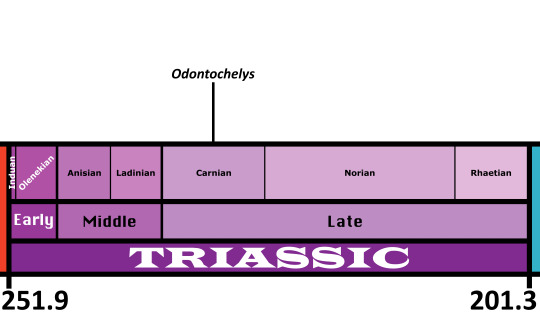
Odontochelys is known from the Lower Member of the Xiaowa Formation of China, commonly known as the Guanling Fauna
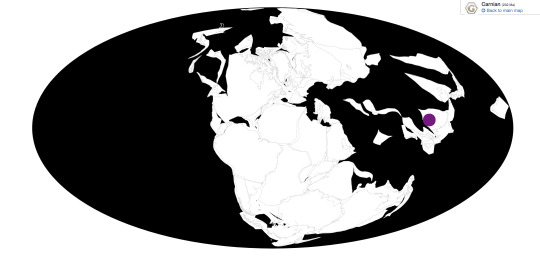
Physical Description: Odontochelys is one of the earliest known turtles - preceded by one, possibly two, precursors other than stem members of the family group - and it showcases how this extremely unique group managed to evolve in the chaos that was the Triassic Explosion. It was simultaneously similar to and very different from living turtles, a true transitional organism. Like other reptiles, it had teeth embedded in its jaws, rather than the toothless beak found in turtle mouths. Like turtles, it had the lower plastron extending from its ribs, but unlike living turtles it had no upper shell - instead, it just had widened ribs and no bony shell around its body. The ribs and the vertebrae were put together differently from modern turtles as well, and its skull was more stretched out compared to its living relatives. It didn’t have fused tail bones, and its scapulae were very different from living turtles. It had short limbs and long, thick fingers, as well as a decently sized shell. It was about forty centimeters long from snout to tail tip.
Diet: The diet of Odontochelys is fairly uncertain, despite us having its teeth; though they are small and peg like, we can’t really extrapolate a function since we don’t actually know its precise ecology! They may have been used for stripping plants, but it’s also possible they were used to chipp up algae and other aquatic water plants, or even invertebrates! So, more research there is clearly needed.
Behavior: The life history of Odontochelys is actually a big mystery. It was found in a marine environment, leading initial studies to indicate it was marine. However, it had the hands of a fresh water organism, including fresh water turtles today. Furthermore, studies of other early turtles indicate that turtles first arose on the land, rather than in the water, and later groups would adapt to water life; the limbs of Odontochelys share similarities with tortoises and support a terrestrial lifestyle. So, the ecology of Odontochelys has been a constant battle. That said, there is some evidence that it was actually marine - and may represent an early experiment in ocean life by turtles. One fossil of Odontochelys indicates that it had completely messed up shoulder bones, likely due to a problem in life rather than destruction of the fossil. This pattern resembles decompression sickness, aka the bends, aka the condition caused by a diving animal coming up much too fast from a lower depth. Modern turtles have complex behavioral adaptations to avoid the bends, so Odontochelys may be an early experiment in marine life in a group mostly adapted for terrestrial life. In this transition to ocean life, it not only lacked better physical adaptations for the ocean, but also better behavioral ones, and was stricken with the bends on its trip back to the surface. So, as we try to determine its ecology and behavior, these clued paint a rich tapestry of the world’s most transitional turtle. A pioneer!
Ecosystem: Odontochelys was found in - and thus, the null hypothesis is that it lived in - an ocean environment near the coast of the Tethys sea. This was a deep, open ocean - pelagic, hence the bends and problems Odontochelys faced trying to deal with the ocean. It was a very fertile ecosystem as well, with a variety of Triassic marine animals showcasing the rapid evolution of these groups. Among the invertebrates, there were many different types of Ammonites, plenty of bivalves, brachiopods, and crinoids & sea cucumbers as well. Still, the fascinating part of the ecosystem was the sheer number of marine reptiles. There were Thalattosaurs such as Anshusaurus and Xinpusaurus; Placodonts like Psephochelys and Sinocyamodus; and Ichthyosaurs like Qianicthyosaurus, Guizhouichthyosaurus, Guanlingsaurus, and Callawayia. One of many beautiful deposits of marine animals from this Period - and the many Ichthyosaurs would have been major predators of the relative n00b Odontochelys.
Other: Odontochelys also just looks really weird because it basically looks like your usual turtle except it doesn’t have a freaking shell so here we are with this oddity. It’s transitional in shape, transitional in ecology, transitional in behavior, and just. What the heck. What the heck, Odontochelys. If you need more proof for evolution despite knowing about the dinosaur - bird transition, have I got a friend for you.
~ By Meig Dickson
Sources Under the Cut
Keep reading
328 notes
·
View notes
Text
Teraterpeton hrynewichorum

By @stolpergeist
Etymology: Wonderful creeping thing
First Described By: Sues, 2003
Classification: Biota, Archaea, Proteoarchaeota, Asgardarchaeota, Eukaryota, Neokaryota, Scotokaryota, Opimoda, Podiata, Amorphea, Obazoa, Opisthokonta, Holozoa, Filozoa, Choanozoa, Animalia, Eumetazoa, Parahoxozoa, Bilateria, Nephrozoa, Deuterostomia, Chordata, Olfactores, Vertebrata, Craniata, Gnathostomata, Eugnathostomata, Osteichthyes, Sarcopterygii, Rhipidistia, Tetrapodomorpha, Eotetrapodiformes, Elpistostegalia, Stegocephalia, Tetrapoda, Reptiliomorpha, Amniota, Sauropsida, Eureptilia, Romeriida, Diapsida, Neodiapsida, Sauria, Archosauromorpha, Crocopoda, Allokotosauria, Trilophosauridae
Status: Extinct
Time and Place: 237 to 227 million years ago, in the Carnian of the Late Triassic

Teraterpeton is known from Nova Scotia.

Physical Description: Teraterpeton was a bizarre archosauromorph. It is an allokotosaur, a member of a clade of relatively large herbivorous archosauromorphs. Some of them, including Teraterpeton, have snouts that lack teeth at the front, but have teeth posteriorly. These toothless regions may have been covered by a “beak” of sorts, similar to those that would evolve many times in ornithodirans. Teraterpeton stands out from its relatives because its snout is very long; about half of the skull would have been the front beak! The front of the upper and lower jaws are toothless and would have tapered to a narrow point anteriorly. The teeth, which were present further back in the jaw, were shaped so that the upper teeth formed a perfect contact with the lower teeth.
Further back on the skull, both the orbit and the nasal openings were large. Also interestingly, one of the temporal fenestrae at the back of the skull is closed. Most diapsids have two large holes in the back of the skull, upper and lower temporal fenestrae. In Teraterpeton, the lower temporal fenestra is closed. This “euryapsid” condition is also present in the marine ichthyosaurs and sauropterygians. Teraterpeton’s neck vertebrae Teraterpeton would have had moderately long legs and a sprawing gait. The claws on both the hands and feet were relatively large.
Diet: Teraterpeton was herbivorous; it likely used the beak at the front to snip off plant matter and used the posterior teeth to chew them up.
Behavior: Unfortunately, little is known about the behavior of allokotosaurs. The limbs were not well-suited for deep digging, but the large claws indicate that they may have been used to grab at something in the ground, such as exposed roots. Like the related Trilophosaurus, Teraterpeton probably grew relatively slowly, and may have had a lower metabolism than more derived archosauromorphs.
Ecosystem: The Wolfville Formation of Nova Scotia is a sandstone, indicating that Teraterpeton lived in a desert. It’s difficult identifying most of the skeletons from this area, as preservation is generally not great, but other creatures that lived in the area include the cynodont Arctotraversodon and the temnospondyl “Metoposaurus” bakeri.
Other: Allokotosaurs are a truly bizarre group of archosauromorphs. There are two main clades: Azendohsauridae, which includes Azendohsaurus, Malerisaurus, and Shringasaurus, and Trilophosauridae, which includes Teraterpeton, Trilophosaurus, Spinosuchus, Variodens, and three scrappy things from Russia that were first identified as procolophonids. There’s also the long-necked, insectivorous Pamelaria.
~ By Henry Thomas
Sources under the cut
Keep reading
178 notes
·
View notes
Text
Thoracopterus
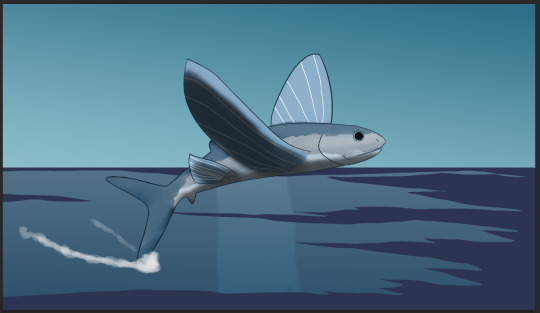
By @evolution-incarnate
Etymology: Chest wings
First Described By: Bronn, 1858
Classification: Biota, Archaea, Proteoarchaeota, Asgardarchaeota, Eukaryota, Neokaryota, Scotokaryota, Opimoda, Podiata, Amorphea, Obazoa, Opisthokonta, Holozoa, Filozoa, Choanozoa, Animalia, Eumetazoa, Parahoxozoa, Bilateria, Nephrozoa, Deuterostomia, Chordata, Olfactores, Vertebrata, Craniata, Gnathostomata, Eugnathostomata, Osteichthyes, Actinopterygii, Peltopleuriformes, Thoracopteridae
Referred Species: T. niederristi, T. magnificus, T. martinsi, T. wushaensis
Status: Extinct
Time and Place: 242 to 209 Ma, from the Ladinian of the Middle Triassic to the Norian of the Late Triassic.

Thoracopterus is known from Italy, Austria, and China.
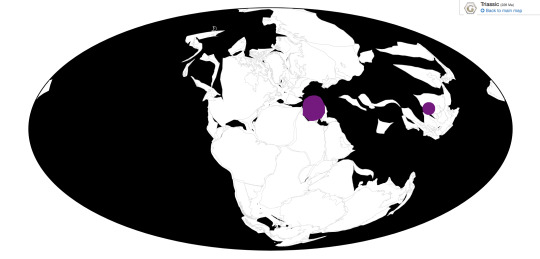
Physical Description: Thoracopterus is one of the earliest known flying fish. Not a flying fish as in the modern group of flying fish (Exocoetidae), but a fish that flies. Thoracopterus’s pectoral and pelvic fins were greatly expanded into wings.. The pectoral wings were almost as long as the rest of the fish! These would have given these fish the ability to glide over the water surface. Besides the wings, Thoracopterus would have looked like an unremarkable fish. Its head was short-snouted and had large eyes, its dorsal fin was placed very far back on the body, and the lower lobe of the caudal fin was longer than the upper one.
Diet: Thoracopterus likely fed on smaller animals, which given how large it was (10 cm at most), would have probably been mostly plankton.
Behavior: It is presumed that thoracopterid behavior was very similar to those of modern flying fish. When threatened by predators, Thoracopterus would likely swim particularly fast to break free from the water surface. When in the air, it would fan out its fins to glide in the air for a considerable distance (modern flying fish can glide for up to 45 seconds), hopefully evading the predator. Jumping is also used during spawning displays in modern flying fish, so this may have also been the case for Thoracopterus. As a small pelagic fish, Thoracopterus likely lived in schools - small pelagic fish tend to do that, because that reduces the chance each individual has of being eaten.
Ecosystem: Thoracopterus fossils are found in Europe and China, which… is the case for a lot of Triassic marine animals, actually. Each environment was pelagic, but probably not too far out from the shore. In Europe, Thoracopterus lived alongside a variety of other fish, such as Belonorhynchus, Saurichthys, Graphiurichthys, Paralepidotus, Peltopleurus, and Pholidopleurus, as well as decapod crustaceans. In China, Thoracopterus lived alongside ammonites like Ptychites and Detoniceras and early marine reptiles, such as the thalattosaur Xinpusaurus and the nothosaur Keichousaurus.
Other: The taxonomy of thoracopterids is a bit of a mess. Phylogenetic analysis suggests that T. martinsi, T. magnificus and T. wushaensis may be more closely related to Gigantopterus and Potanichthys than to the type species of Thoracopterus, T. niederristi. However, it has also been suggested that Potanichthys is the same species as the earlier-named T. wushaensis, so then that becomes Thoracopterus and only Gigantopterus stands out. Or you could lump them all, including Gigantopterus, into Thoracopterus. It really depends on where you set your genericometer. For the purposes of this article, I have described Thoracopterus sensu lato.
~ By Henry Thomas
Sources under the cut
Keep reading
140 notes
·
View notes